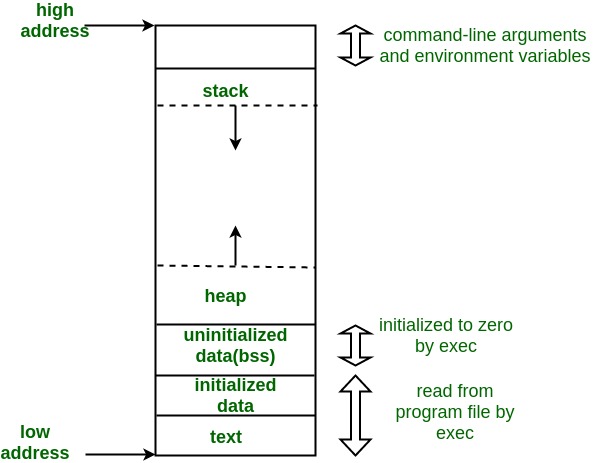Linux virtual memory area(VMA)
本章首先给出Linux virtual memory area(VMA)的layout,这是结论,然后描述如何编写程序来进行验证(在./Verification章节进行描述)或者说如何得出这个结论。
cnblogs Linux进程虚拟地址空间布局
在32 bit系统中,内核分配1GB,而各个用户空间进程可用的部分为3GB。
下图展示了一个32位系统的进程虚拟地址空间的布局:

进程虚拟地址空间由若干个区域组成:
1.当前运行代码的二进制代码.text段。
2.程序使用的动态库代码。
3.存储**区局变量**和**静态变量**的数据段,bss,data段
4.保存动态分配数据的堆
5.保存局部变量和实现**函数调用**的栈
6.环境变量和命令行参数。
7.文件内容映射到虚拟地址空间的内存映射。
如果全局变量randomize_va_space设置为1,那么启用地址**空间随机化机制**(上图的ramdom xxx offset)。用户可以通过/proc/sys/kernel/randomize_va_space停用该特性。
每个进程都有mm_struct(linux/mm_types.h)的实例,保存**进程虚拟内存管理信息**。
struct mm_struct {
struct vm_area_struct *mmap; /* list of VMAs */
struct rb_root mm_rb;
#ifdef CONFIG_MMU
unsigned long (*get_unmapped_area) (struct file *filp,unsigned long addr, unsigned long len,unsigned long pgoff, unsigned long flags);
#endif
unsigned long mmap_base; /* base of mmap area */虚拟地址空间中用于内存映射的起始地址。
unsigned long mmap_legacy_base; /* base of mmap area in bottom-up allocations */
unsigned long task_size; /* size of task vm space */进程地址空间的size.
struct list_head mmlist; /* List of maybe swapped mm's. These are globally strung
unsigned long start_code, end_code, start_data, end_data;//text段,数据段的起始地址和终止地址
unsigned long start_brk, brk, start_stack;//堆首地址,堆尾地址,栈首地址。
unsigned long arg_start, arg_end, env_start, env_end;//命令行参数,环境变量的起始地址和终止地址
....
};
**进程虚拟地址空间**由多个VMA组成(struct mm_struct中struct vm_area_struct \*mmap;/* list of VMAs */成员)。有两种组织VMA的方式,链表(mmap)和红黑树(mm_rb)
VMA结构体如下:
struct vm_area_struct {
/* The first cache line has the info for VMA tree walking. */
unsigned long vm_start; /* Our start address within vm_mm. */
unsigned long vm_end; /* The first byte after our end address within vm_mm. */
/* linked list of VM areas per task, sorted by address */
struct vm_area_struct *vm_next, *vm_prev;
struct rb_node vm_rb;
struct mm_struct *vm_mm; /* The address space we belong to. */
/* Function pointers to deal with this struct. */
const struct vm_operations_struct *vm_ops;
struct file * vm_file; /* File we map to (can be NULL). */
void * vm_private_data; /* was vm_pte (shared mem) */
};
VMA链表组织形式如下图:

VMA红黑树组织形式如下:

geeksforgeeks Memory Layout of C Programs
A typical memory representation of C program consists of following sections.
\1. Text segment \2. Initialized data segment (usually called simply the Data Segment) \3. Uninitialized data segment (often called the “bss” segment) \4. Stack \5. Heap
gnu libc 3.1 Process Memory Concepts
A process’ virtual address space is divided into segments. A segment is a contiguous range of virtual addresses. Three important segments are:
1、The text segment contains a program’s instructions and literals and static constants. It is allocated by exec and stays the same size for the life of the virtual address space.
2、The data segment is working storage for the program. It can be preallocated and preloaded by exec and the process can extend or shrink it by calling functions as described in See Resizing the Data Segment. Its lower end is fixed.
3、The stack segment contains a program stack. It grows as the stack grows, but doesn’t shrink when the stack shrinks.
TODO
https://blog.csdn.net/feilengcui008/article/details/44141495
https://www.cnblogs.com/dyllove98/archive/2013/07/05/3174341.html
https://inst.eecs.berkeley.edu/~cs161/sp15/slides/lec3-sw-vulns.pdf
https://inst.eecs.berkeley.edu/
https://cpp.tech-academy.co.uk/memory-layout/
https://cpp.tech-academy.co.uk/
https://stackoverflow.com/questions/3080375/how-is-the-memory-layout-of-a-c-c-program
